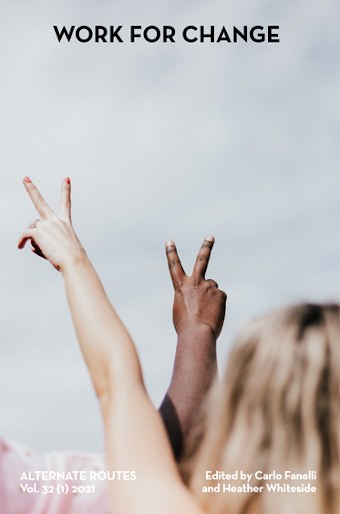In the Fight of Our Lives: Working for Change, Changing Work
The last province to join Canada, largely to settle its fiscal imbalance in a post-war world, is in trouble. Pandemic-related socio-economic issues, coupled with low per capita income, high debt, and a resource-dependent economy, continue to push the search for solutions in Newfoundland and Labrador, as elsewhere, in strangely familiar ways. ‘Last in’ might just prove to be ‘first out’ when it comes to Canada’s progressive hopes for the future. Premier Andrew Furey’s economic recovery team (PERT) released The Big Reset, with recommendations for deep cuts to health and post-secondary education spending, privatization of public sector pensions and provincially owned businesses, new public-private partnerships (P3s), taxes and user-fees (Executive Council 2021; The Big Reset 2021).
The report was crafted by none other than the province’s itinerant Dame Moya Greene who helped privatize the Canadian National Railway, deregulate the Canadian airline industry, commercialize Canada Post and Canadian ports, and shepherd the privatization of the Royal Mail in Britain. It should therefore come as no surprise that a plan purporting to envision a green future for a province reliant on oil, cloaks austerity and fossil fuel-reliance in a concern for debt. But while overtures of fiscal sustainability foregrounds the analysis, The Big Reset is none other than a declaration of class war from above that seeks to make life ever more market-reliant and shift the recovery costs of COVID-19 away from capital and onto working class communities.1

The travails of Newfoundland and Labrador are but one example in a growing chorus of those invoking debt and the need for austerity in what is likely to become a global flashpoint of contention for years, if not decades, to come (Furceri et al., 2021; Abdo, 2021).
From Rescue to Recovery Strategies
As the COVID-19 crisis evolved, governments around the world intervened with trillions in broad tax relief, wage subsidies, grants, preferential loans, and other guarantees to prevent widespread economic collapse and support the recovery. Governments also took equity stakes in everything from energy, rail, automotive, and air transportation to support troubled firms. At the midway point of 2020, global economic stimulus amounted to $10-trillion, three times more than the collective responses to the Great Financial Crisis (Cassim et al., 2020). By year-end, this had grown to over $20-trillion, with the value of COVID-19 fiscal stimulus packages as a percentage of Gross Domestic Product (GDP) in some G20 countries surpassing more than 50 per cent (IMF, 2020; OECD, 2021). A recent IMF report, A long and Difficult Ascent, spoke of the “difficult trade-offs between implementing measures to support near-term growth and avoiding a further buildup of debt that will be hard to service down the road” (IMF 2020b). While it did recommend some modest tax and revenue measures to support the economy, it also cautioned of debt sustainability and reminded of the familiar need to remove targeted support in the future.
In a rare, candid moment of ruling class honesty, Mario Draghi, former President of the European Central Bank (2011-2019) and current Prime Minister of Italy, alluded to what likely lies ahead, writing, "The loss of income incurred by the private sector — and any debt raised to fill the gap — must eventually be absorbed, wholly or in part, on to government balance sheets. Much higher public debt levels will become a permanent feature of our economies and will be accompanied by private debt cancellation" (Draghi, 2021). Like the Great Recession a decade earlier, private debt is increasingly at risk of becoming public debt, with corporations and the well-heeled disproportionately benefitting (Konzelmann, 2019; Shefner and Blad, 2020; Whiteside et al., 2021). Adding to the uncertainty is what will become of historically low interest rates, with some cautioning a return to the hyperinflation of the 1970s and others disregarding these fears as overblown (Moss, 2021; Pitis, 2021). If neoliberalism was sacrificed on the altar of 2008 through proof that private markets are not wholly efficient, welfare-maximizing, and self-regulating, 2020-21 taught that government intervention, public ownership, and support for essential services were needed to recuse capitalism from a crisis it was wholly incapable of dealing with.
Pushed to the margins, workers are in the fight of their lives: on the frontlines of the pandemic, in their homes and workplaces, for climate justice, and against the daily precariousness of life under capitalist oppression and exploitation. Globally, poverty rates have risen sharply with close to one-hundred million joining the ranks of the extreme poor (earning less than $1.90 (US) per day), and an additional eighty million more undernourished than before the pandemic. Cumulative per capita income losses over 2020-22, compared with pre-pandemic projections, are equivalent to 20 per cent of GDP in emerging and developing countries (excluding China), while in advanced economies the losses are expected to be roughly half (OECD, 2021). COVID-19 has impacted the world of work and workers in unprecedented ways. A recent ILO (2021) report shows that 255 million jobs have been lost, with global unemployment increasing by thirty-three million, while more than eighty million have left the ranks of the labour market altogether. Divergent recovery paths are reflected in accelerating inequality, within and across the global North and South. Global labour income has declined by US$3.7-trillion (8.3 per cent), or 4.4 per cent of global GDP.
Loss of income has disproportionately impacted youth, women, racialized and lower-educated workers who have experienced the most dramatic declines in disposable income, which contrasts sharply with job growth in a number of higher-educated services sectors. If present trends continue for an extended period of time, these differential impacts are likely to leave a generational scar on labour force participation, productivity growth, and global macroeconomic stability. For instance, the ILO (2021) has forecasted an additional loss of 90 million full-time jobs by end of 2021. Informal workers’ earnings, which comprise some two billion people worldwide, often without labour rights and social protections, have been cut in half. For migrant workers, a sector dominated by long-standing employment and human rights violations and exemptions, work and living conditions have gone from bad to worse, with a growing preponderance of non- or underpayment for work performed (Foley and Piper, 2021). And, for the first time in two decades, the number of child labourers has risen, which now stands at more than one-hundred and sixty million worldwide – an increase of more than eight million, with estimates suggesting this number could rise by more than forty-six million in the absence of extended social protections (UNICEF, 2021).
As noted in an earlier issue of Alternate Routes (Fanelli and Whiteside, 2020) pandemic-induced insecurity has only strengthened the grip of ruling classes worldwide. The speed and scale of billionaire growth is unprecedented, with the world’s 2,755 billionaires now worth $13.1-trillion, up more than sixty-two per cent from $8-trillion just a year ago (Jackson, 2021; Tognini, 2021). A recent report from Oxfam (2021) suggests that the world’s ten richest men have seen their combined wealth increase by half a trillion dollars since the pandemic began, more than enough to pay for a COVID-19 vaccine for everyone and to ensure no one is pushed into poverty by the pandemic. Likewise, top financial institutions report record profits, all the while benefitting from a global tax system that conveys disproportionate advantages to the wealthy (Evans, 2021; Eisinger et al., 2011). The contrast between the world’s wealthiest and those trying to make ends meet calls attention to the needs to build back better – a theme first raised by the United Nations in 2015 but given added emphasis in the context of COVID-19 (and which will be the focus of Alternate Routes’ forthcoming issue). In the context of these challenges, the apocalyptic scale of the 2020-21 pandemic through loss of life and livelihoods offers both hope and fear for the future.
Fighting for the Future
In addition to mounting political and economic upheavals, there is a growing consensus that COVID-19 is here to stay in some form for the foreseeable future (Philips, 2021). This makes the task of reorganizing society in more socially just and equitable ways all the more urgent. As James Meadway (2021) has noted, “COVID-19 emerged at a specific point in our history. It has spread because of how we organise ourselves, and the path the pandemic takes from here onwards will depend on that social organization… COVID is, in other words, a disease of capitalism, and it is in this register that it is best understood.” Across the ideological spectrum, new divisions emerge too, emanating not just from the anti-vaxx/anti-lockdown conspiracy theorists but also in terms of how executive power is increasingly inoculated from parliamentary scrutiny and accountability, all the while multiplying state surveillance, legalized restrictions, and policing modalities for the disciplining of dissent by the ‘austerity state’.
COVID-19 responses have underlined the enduring importance of an active and interventionalist state (and interstate system) in the making and remaking of global capitalism (Panitch and Gindin, 2015). They have also shown, one hopes, the need to reconfigure existing public institutions: not just less market and more state, but a different kind of public sector delinked from capitalist profitability. For instance, despite for-profit long term care homes being associated with higher rates of injury, illness, and death – both before and since COVID-19 – Ontario’s Long-Term Care Commission (2021) still saw it fit to argue for further privatization and marketization of the sector (Ontario Health Coalition, 2020; PressProgress, 2020; Annable et al., 2021). In a similar way, the Canada Infrastructure Bank has committed to further commercialization of infrastructure spending – that is, a P3 model that socializes risks and embeds higher costs into public works (see Whiteside, 2021). These recent examples are just the latest in a catalogue of publicly subsidized private capitals living off state largesse (Mazzucato, 2020; Tasker, 2021).
Springing from the dark days of the pandemic, the increasing availability of vaccines has provided a lifeline for those most vulnerable. However, this will likely continue to be uneven as a result of unequal vaccine access and the limited capacity of most developing and emerging economies to support strong fiscal stimulus measures. Instead, dramatic inequality in distribution and access reigns, with the top ten wealthiest countries utilizing some 75 per cent of all vaccines (Nebehey, 2021). Pharmaceutical companies have also reaped billions in profits despite the fact the “cost of COVID-19 vaccine development was largely paid for by government” (Olive, 2021; see also, Ziady, 2021; Katz et al., 2020; Stephenson, 2021). As ILO President, Guy Ryder recently noted, “The world needs to invest in a human-centred recovery from the crisis and focus on achieving resilience through the pursuit of social justice.” Better labour laws, improved social protections, and a stronger voice for workers’ organizations will be central to any successful and sustainable recovery (Evans et al., 2021). Initiatives such as these are political and policy choices, not simple determinants of economic competitiveness.
Calls to Build Back Better have certainly opened-up space for progressive voices long in the shadows of neoliberalism’s most vocal proponents. In this regard, it is imperative to take stock of capitalism’s powerful tendency to undermine capacities and incorporate progressive politics. The crisis of so-called ‘centrism’ (Albo and Leys, 2021; Fanelli and Whiteside, 2020) calls attention to the urgent task of rebuilding and renewing socialist politics – of getting people to think ambitiously again, and of meeting new challenges through unique solutions left of social democracy.
Fortunately, pathways for such socialist practice have been provided by three greats in the Canadian political economy tradition: Mel Watkins, John Loxley, and Leo Panitch. Although their passing in 2020 has been heartbreaking for many, their legacy is all the brighter today as their signature contributions shine a light on how we can fight for a future worth living. Together, their analyses of imperialism, cooperative community development, global working-class struggles, and support for workers and public services, are not just solutions for problems of their day but signposts toward a better future. During a time of so much loss, we also bid fond farewell to these three comrades with high hopes for the future through their legacy and through the best ideas offered by the left today. •
This is the introductory essay of the 2021 issue of Alternate Routes.
References
- Abdo, N. (2021). Austerity is not a fair shot: 4 observations on the IMF’s latest COVID-19 loans. Oxfam International.
- Annable, K., Kubinec, V-L., Barghout, C., Levasseur, J. (17 March 2021). For-profit care homes have higher COVID-19 death rates among Winnipeg nursing homes. CBC News.
- Cassim, Z., Handjiski, B., Schubert, J., and Y. Zouaoui. (2020). The $10-trillion rescue: How governments can deliver impact. McKinsey and Company.
- Draghi, M. (25 March 2020). Draghi: we face a war against coronavirus and must mobilise accordingly. Financial Times.
- Evans, P. (27 May 2021). “Earnings bonanza continues at big banks as RBC, TD and CIBC profits up by more than 100%.” CBC News.
- Executive Council. (6 May 2021). Premier’s Economic Recovery Team Release Report. News Releases. Newfoundland and Labrador.
- Fanelli, C., and H. Whiteside. (2020). COVID-19, Capitalism and Contagion. Alternate Routes: A Journal of Critical Social Research, 31(1), 6-27.
- Foley, L. and N. Piper. (2021). Returning home empty handed: Examining how COVID-19 exacerbates the non-payment of temporary migrant workers’. Global Social Policy.
- Furceri, D., Loungani, P., Ostry, J.D. and P. Pizzuto. (2021). Fiscal austerity intensifies the increase in inequality after pandemics. Vox EU.
- International Labor Organization. (2021). COVID-19 recovery must be human-centred. ILO.
- International Monetary Fund. (2020). World Economic Outlook: A Long and Difficult Ascent. IMF.
- International Monetary Fund. (2020b). A Year Like No Other: 2020 Annual Report. IMF.
- Katz, I.T., Weintraub, R., Bekker, L.G. and A.M. Brandt. (2021). From Vaccine Nationalism to Vaccine Equity – Finding a Path Forward. The New England Journal of Medicine. 384, 1281-1283.
- Konzelmann, S.J. (2019). Austerity. Cambridge: Polity.
- Moss, D. (14 February 2021). Inflation Fears Are Overblown. Bloomberg.
- Nebehey, S. (24 May 2021). ‘Scandalous inequity’: WHO says 75% of vaccines given out in just 10 countries. Global News.
- Jackson, H. (7 April 2021). Total number of billionaires up 30% amid COVID-19 pandemic. Global News.
- Ontario Health Coalition. (6 May 2020). COVID-19 Death Rates in Ontario Long-Term Care Homes Significantly Higher and Increasing in For-Profit Homes vs. Non-Profit and Publicly-Owned Homes: New Data Analysis.
- Ontario. Long-Term Care COVID-19 Commission. (25 May 2021). Long-Term Care COVID-19 Commission: final report and progress on interim recommendations.
- Organization for Economic Cooperation and Development. (2021). No Ordinary Recovery: Navigating the Transition.
- Olive, D. (3 June 2021). Governments paid billions to help develop COVID-19 vaccines – so why is Big Pharma charging us billions more for the vaccines we helped create? Toronto Star.
- Oxfam International. (2021). Mega-rich recoup COVID-losses in record-time yet billions will live in poverty for at least a decade.
- Philips, N. (16 February 2021). The coronavirus is here to stay – here’s what that means. Nature.
- PressProgress. (22 December 2020). Experts Say Long-Term Care Company’s Report on COVID-19 Deaths Deflects Blame From For-Profit Business Model.
- Public Service Alliance of Canada (PSAC). (28 January 2021). New report reinforces need to make Revera long-term care public.
- Shefner, J., and C. Blad, (2020). Why Austerity Persists. Cambridge: Polity.
- Stephenson, J. (2021). Unequal Access to COVID-19 Vaccines Leaves Less-Wealthy Countries More Vulnerable, Poses Threat to Global Immunity. JAMA Health Forum. 2(3).
- Tasker, J.P. (18 May 2021). Federal government invests $200-million to build an mRNA vaccine plant in Ontario.” CBC News.
- Tognini, G. (6 April 2021). Meet The 40 New Billionaires Who Got Rich Fighting Covid-19. Forbes.
- The Big Reset. (2021). The Big Reset: The Report of the Premier’s Economic Recovery Team. Newfoundland and Labrador.
- The People’s Recovery. (2021). The People’s Recovery: A Discussion Paper.
- UNICEF. (2021). Child labour rises to 160 million – first increase in two decades.
- Whiteside, H., McBride, S. and B. Evans. (2021). Varieties of Austerity. Bristol: Bristol University Press.
- Whiteside, H. (9 March 2021). Standing Committee on Transport, Infrastructure and Communities (TRAN). 43rd Parliament, 2nd Session.
- Ziady, H. (21 May 2021). Covid vaccine profits mint 9 new pharma billionaires. CNN.
Endnotes
- On an alternative framework, see The People’s Recovery (2021), a grassroots-led alternatively advocates for fairness, sustainability, and equity in forging pathways forward.





